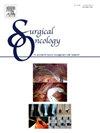Preoperative multiparametric magnetic resonance imaging based risk stratification system for predicting biochemical recurrence after radical prostatectomy
IF 2.3
4区 医学
Q3 ONCOLOGY
引用次数: 0
Abstract
Background
Multiparametric magnetic resonance imaging (mpMRI) is used as a current marker in preoperative staging and surgical decision-making, but current evidence on predicting post-surgical oncological outcomes based on preoperative mpMRI findings is limited. In this study We aimed to develop a risk classification based on mpMRI and mpMRI-derived biopsy findings to predict early biochemical recurrence (BCR) after radical prostatectomy.
Methods
Between January 2017 and January 2023, the data of 289 patients who underwent mpMRI, transrectal ultrasound-guided cognitive and fusion targeted biopsies, and subsequent radical prostatectomy (RP) with or without pelvic lymph node dissection in a single center were retrospectively re-evaluated. BCR was defined as a prostate specific-antigen (PSA) ≥ 0.2 ng/mL at least twice after RP. Multivariate logistic regression models tested the predictors of BCR. The regression tree analysis stratified patients into risk groups based on preoperative mpMRI characteristics. Receiver operating characteristic (ROC)-derived area under the curve (AUC) estimates were used to test the accuracy of the regression tree–derived risk stratification tool.
Results
BCR was detected in 47 patients (16.2 %) at a median follow-up of 24 months. In mpMRI based multivariate analyses, the maximum diameter of the index lesion (HR 1.081, 95%Cl 1.015–1.151, p = 0.015) the presence of PI-RADS 5 lesions (HR 2.604, 95%Cl 1.043–6.493, p = 0.04), ≥iT3a stage (HR 2.403, 95%Cl 1.013–5.714, p = 0.046) and ISUP grade ≥4 on biopsy (HR 2.440, 95%Cl 1.123–5.301, p = 0.024) were independent predictors of BCR. In regression tree analysis, patients were stratified into three risk groups: maximum diameter of index lesion, biopsy ISUP grade, and clinical stage on mpMRI. The regression tree–derived risk stratification model had moderate-good accuracy in predicting early BCR (AUC 77 %)
Conclusion
Straightforward mpMRI and mpMRI-derived biopsy-based risk stratification for BCR prediction provide an additional clinical predictive model to the currently available pathological risk tools.
基于多参数磁共振成像的术前风险分层系统,用于预测根治性前列腺切除术后的生化复发。
背景:多参数磁共振成像(mpMRI)是目前用于术前分期和手术决策的标志物,但目前根据术前 mpMRI 检查结果预测术后肿瘤结果的证据有限。在这项研究中,我们旨在根据 mpMRI 和 mpMRI 衍生的活检结果制定一种风险分类,以预测根治性前列腺切除术后的早期生化复发(BCR):在2017年1月至2023年1月期间,回顾性重新评估了在一个中心接受mpMRI、经直肠超声引导的认知和融合靶向活检以及随后接受根治性前列腺切除术(RP)并进行或不进行盆腔淋巴结清扫的289名患者的数据。前列腺癌根治术后至少两次前列腺特异抗原(PSA)≥0.2纳克/毫升即为BCR。多变量逻辑回归模型检验了 BCR 的预测因素。回归树分析根据术前 mpMRI 特征将患者分为不同的风险组。接收者操作特征(ROC)得出的曲线下面积(AUC)估计值用于检验回归树衍生风险分层工具的准确性:结果:在中位随访 24 个月时,47 例患者(16.2%)被检测出 BCR。493,p = 0.04)、≥iT3a 分期(HR 2.403,95%Cl 1.013-5.714,p = 0.046)和活检时 ISUP 分级≥4(HR 2.440,95%Cl 1.123-5.301,p = 0.024)是 BCR 的独立预测因素。在回归树分析中,患者被分为三个风险组:指标病变最大直径、活检 ISUP 分级和 mpMRI 临床分期。回归树衍生的风险分层模型在预测早期 BCR 方面具有中等偏上的准确性(AUC 77 %)。
本文章由计算机程序翻译,如有差异,请以英文原文为准。
求助全文
约1分钟内获得全文
求助全文
来源期刊

Surgical Oncology-Oxford
医学-外科
CiteScore
4.50
自引率
0.00%
发文量
169
审稿时长
38 days
期刊介绍:
Surgical Oncology is a peer reviewed journal publishing review articles that contribute to the advancement of knowledge in surgical oncology and related fields of interest. Articles represent a spectrum of current technology in oncology research as well as those concerning clinical trials, surgical technique, methods of investigation and patient evaluation. Surgical Oncology publishes comprehensive Reviews that examine individual topics in considerable detail, in addition to editorials and commentaries which focus on selected papers. The journal also publishes special issues which explore topics of interest to surgical oncologists in great detail - outlining recent advancements and providing readers with the most up to date information.
 求助内容:
求助内容: 应助结果提醒方式:
应助结果提醒方式:


